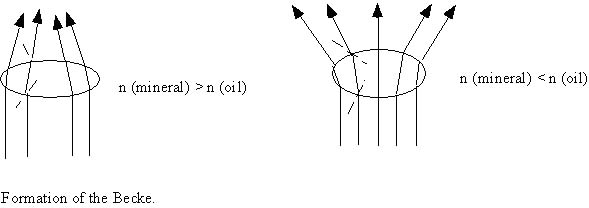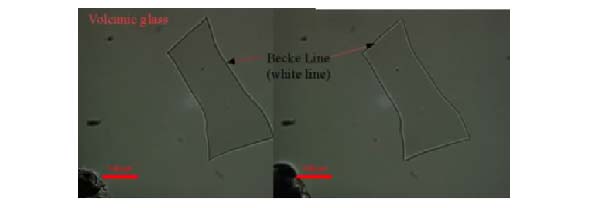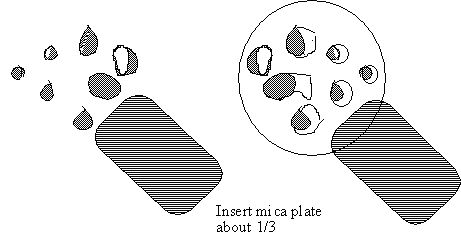
Becke Lines: These are caused by refraction effects, and concentrate light near the edges of the mineral. The Becke line method is good for comparing the refractive index of the oil with that of the mineral. When the stage is moved up or down, the Becke line(s) also move in and out of the mineral. The direction of movement of the Becke Line is determined by lowering the stage with the Becke Line always moving into the material with the higher refractive index. The Becke Line can be considered to form from a cone of light that extends upwards from the edge of the mineral grain.

As you increase the distance between the stage and the objective lenses the Becke lines will move to the material with the highest refractive index. If you decrease the distance between the stage and the objective lenses the Becke line will move to the material with smaller refractive index.
There are two photographs showing a grain of volcanic glass are on the next
page.:
1.The grain in focus, with the Becke line lying at the grain boundary.
2.The stage is raised up, such that the grain boundary is out of focus, but
the Becke line is visible inside the grain.

When the RI of the mineral and the RI of the mounting material are equal, the
Becke line splits into two lines, a blue line and an orange line. In order to
see the Becke line the microscope is slightly out of focus, the grain appears
fuzzy, and the two Becke lines are visible. The blue line lies outside the grain
and the orange line lies inside the grain. As the stage is raised or lowered
the two lines will shift through the grain boundary to lie inside and outside
the grain, respectively.
Excercise:
Using the mineral fluorite and an oil that has the same RI as the mineral, do
the above experiment and turn in a photograph that shows blue and orange lines
around the mineral.
Oblique method of refractive index determination: If you have grains
in an oil and partially insert the accessory plate, about 1/3 grains will be
shaded either on the same side from where you are inserting the plate or on
the opposite site depending on their refractive index compared with the oil.
